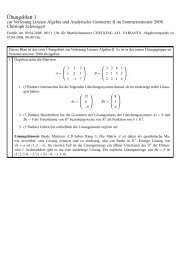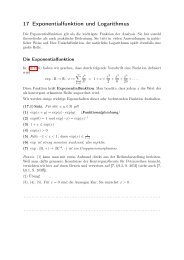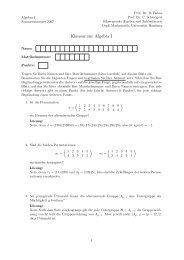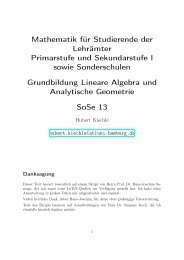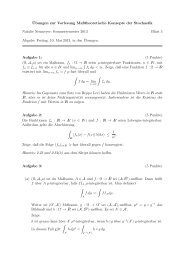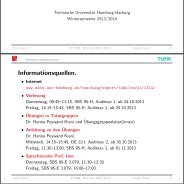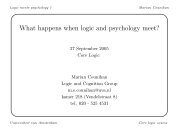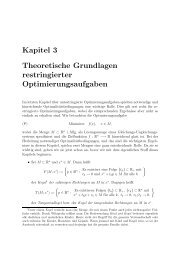pdf file
pdf file
pdf file
You also want an ePaper? Increase the reach of your titles
YUMPU automatically turns print PDFs into web optimized ePapers that Google loves.
4. d H (v, w) = d H (v + u, w + u) for all u, v, w ∈ V (translation invariance)<br />
Definition 5.5.4<br />
For λ ∈ N, a subset C ⊂ (F 2 ) n is called a λ–error correcting code, if<br />
d H (u, v) ≥ 2λ + 1 for all u, v ∈ C with u ≠ v .<br />
The reason for this name is the following<br />
Lemma 5.5.5.<br />
Let C ⊂ V be a λ-error correcting code. Then for any v ∈ V , there is at most one w ∈ C with<br />
d H (v, w) ≤ λ.<br />
Proof.<br />
Suppose we have w 1 , w 2 ∈ C with d H (v, w i ) ≤ λ for i = 1, 2. Then the triangle inequality yields<br />
d H (w 1 , w 2 ) ≤ d H (w 1 , v) + d H (v, w 2 ) ≤ 2λ .<br />
Since the code C is supposed to be λ-error correcting, we have w 1 = w 2 .<br />
✷<br />
Remarks 5.5.6.<br />
1. It is important to keep in mind the relative situation: a code C is a subspace of F n 2. The<br />
Hemming distance gives an indication that it is important to keep the subspace C of code<br />
words spread out in V .<br />
2. We say that information is stored in the code, if an element c ∈ C is selected.<br />
3. If C ⊂ F n 2, we say that a codeword of C is composed of n bits. If C is a linear code with<br />
dim F2 C = k, we refer to a [n, k] code. Denote by<br />
d :=<br />
min d H (c, 0)<br />
c∈C\{0}<br />
the minimal distance of a code. We refer to an [n, k, d] code. In practice, the length n<br />
of the code has to be kept small, because this causes costs for storing and transmitting.<br />
The minimal distance d has to be big, since by lemma 5.5.5 this allows to many correct<br />
errors. The dimension k of the code has to be big enough to allow enough code words.<br />
From elementary linear algebra, one derives the singleton bound<br />
k + d ≤ n + 1<br />
which shows that these goals are in competition.<br />
4. Classical storage devices are typically localized, either in space (e.g. an electron or a<br />
nuclear spin) or in momentum space (e.g. a photon polarization).<br />
5. Many storage devices are magnetic, i.e. a collection of coupled spins. The Hamiltonian<br />
is such that it favours the alignment of spins. So if one spin is kicked out by thermal<br />
fluctuation, the Hamiltonian tends to push it back in the right position. Thus errors in<br />
the storage device are corrected by the dynamics of the system. This idea will also enter<br />
in the construction of quantum codes.<br />
140






